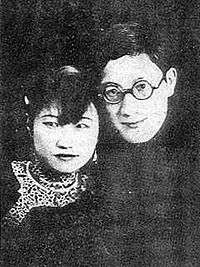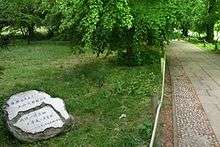Xu Zhimo
| Xu Zhimo | |
|---|---|
 Xu Zhimo | |
| Born |
15 January 1897 Haining, Zhejiang |
| Died |
19 November 1931 (aged 34) Tai'an, Shangdong |
| Cause of death | Plane crash |
| Alma mater | |
| Spouse(s) |
|
| Relatives | Jin Yong (cousin) |
Xu Zhimo (Chinese: 徐志摩; pinyin: Xú Zhìmó; Wade–Giles: Hsü Chih-mo, January 15, 1897 – November 19, 1931) was an early 20th-century Chinese poet. Xu Zhimo, original name Xu Yousen, pseudonyms Nanhu and Shizhe (b. 1896, Xiashi, Zhejiang province, China—d. Nov. 19, 1931, Jinan, Shandong province), was a free-thinking Chinese poet who strove to loosen Chinese poetry from its traditional forms, and to reshape it under the influences of Western poetry and the vernacular Chinese language.[1]
One of the most renowned romantic poets of 20th-century Chinese literature, he is known for his promotion of modern Chinese poetry and made contributions to modern Chinese literature.
"Returning to China in 1922, Xu Zhimo began writing poems and essays in the vernacular style. He fell under the influence of the Indian poet Rabindranath Tagore while he was serving as interpreter for him during a lecture tour of China. All the foreign literature to which Xu Zhimo had been exposed served to shape his own poetry and establish him as a leader in the modern poetry movement in China."[1] He helped bring big changes to Chinese Literature from that period.
To commemorate Xu Zhimo, in July 2008, a stone of white Beijing marble was installed at the Backs of King's College, Cambridge (near the bridge over the River Cam); Xu's best-known poem called (simplified Chinese: 再别康桥; traditional Chinese: 再別康橋; pinyin: Zài Bié Kāngqiáo; literally: "again (or "once more") leave Cambridge", variously translated as "On Leaving Cambridge", "Saying Goodbye to Cambridge Again", "Goodbye Again, Cambridge", "Leaving the Revisited Cambridge" etc.). A collection of Xu's poetry with English translations was published by Oleander Press Cambridge in 2012.[2]
Biography

Xu was born in Haining, Zhejiang and graduated from the famous Hangzhou High School. In 1915, he married Zhang Youyi and next year he went to Peiyang University (now Tianjin University) to study Law. In 1917, he transferred to Peking University (PKU) due to the law department of Peiyang University merging into PKU. In 1918, he traveled to the United States to study history at Clark University in Worcester, Massachusetts where he earned his bachelor's degree. Shortly afterwards, he transferred to Columbia University in New York to study economics and politics in 1919. Finding the States "intolerable", he left in 1921[3] to study at King's College, Cambridge in England, where he fell in love with English romantic poetry like that of Keats and Shelley, and was also influenced by the French romantic and symbolist poets, some of whose works he translated into Chinese. In 1922 he returned to China and became a leader of the modern poetry movement. In 1923, he founded the Crescent Moon Society. When the Bengali poet Rabindranath Tagore visited China, Xu Zhimo played the part of oral interpreter. Xu was also renowned for his use of vernacular varieties of Chinese. He was one of the first Chinese writers to successfully naturalize Western romantic forms into modern Chinese poetry. He worked as an editor and professor at several schools before dying in a plane crash on November 19, 1931 near Tai'an, Shandong[4] while flying on a Stinson Detroiter from Nanjing to Beijing. He left behind four collections of verse and several volumes of translations from various languages.
Love affairs
Xu Zhimo's various love affairs with Zhang Youyi, Lin Huiyin, and Lu Xiaoman are well known in China. Xu married Zhang Youyi,[5] (the sister of the politician Zhang Junmai) on October 10, 1915. This was an arranged marriage that went against Xu’s belief in free and simple love. Although Zhang gave birth to two sons, Xu still couldn’t accept her. While in London in 1921, Xu met and fell in love with Lin Huiyin (the daughter of Lin Changmin). He divorced Zhang in March 1922. Inspired by this newly found love, Xu wrote a large number of poems during this time. Lin and Xu became close friends. However, she was already betrothed to Liang Sicheng by his father. Xu's last lover was Lu Xiaoman, who was married to Wang Geng, a friend of Xu. The marriage had been arranged by her parents and she felt trapped in this loveless marriage. When Xu and Lu met, they quickly bonded over the similarity of their respective experiences with arranged marriages. When it came to be known that they were in love, both were scorned by their parents and friends. Lu divorced her husband in 1925 and married Xu the next year.[5] Their honeymoon period did not last long however and Lu gradually became more and more depressed. Because Lu was wasteful and Xu’s parents refused to lend them money, Xu had to take several jobs in different cities to keep up with the lifestyle Lu desired. She was widowed when Xu died in an airplane crash.
Xu was also romantically linked to American author Pearl S. Buck and American journalist Agnes Smedley.[6]
Airplane crash
On November 19, 1931, Xu Zhimo prepared to leave Nanking to attend a lecture given by Lin Huiyin at a university in Peking.[7] He boarded a China Airways Federal Stinson Detroiter,[8] an aircraft contracted by Chunghwa Post to deliver airmail on the Nanjing-Beijing route.[9] However, when the flight arrived in the Jinan area, the flight encountered severe fog, leaving the pilot with no clear view to land. The plane descended into the mountainous area below unnoticed as both the pilots were looking for the course according to the map. When the aircraft was aiming to turn left to go back to the course again, it hit the peak of a mountain and broke off the right wing. The plane spun out of control and crashed into the mountains near Tai'an City, in Shandong province.[4][10] Xu Zhimo, who suffered from fatal cerebral trauma and several cuts on his body, was killed instantly as well as one of the two pilots.[11][12] The first officer however, survived the initial impact, but also perished due to protracted rescue.
It is believed that the accident was attributed to both pilots' misjudgement of the flight's altitude as well as failing to recognize the terrain surrounding them, which is considered as a typical CFIT.
Some rumors, however, outcry that the death of Xu Zhimo turned out to be a murder,[13][14] but it was confirmed untrue.
Cambridge poem

English versions have been published under various titles;[15][16] the one used here (by permission) was translated by Guohua Chen and published in the University of Cambridge's 800th anniversary book.[17]
再别康橋 |
Taking Leave of Cambridge Again |
References
| Wikimedia Commons has media related to Xu Zhimo. |
- 1 2 ["Xu Zhimo." Encyclopædia Britannica (2014): Research Starters. Web. 27 Jan. 2016. "Xu Zhimo." Encyclopædia Britannica (2014): Research Starters. Web. 27 Jan. 2016.] Check
|url=value (help). Missing or empty|title=(help) - ↑ Xu, Zhimo, "Selected Poems", Oleander Press, 2012. ISBN 9780900891694. This is a collection of uncredited English translations of Xu's most famous poems, plus Xu's Chinese translations of his favourite English poetry.
- ↑ Study at King's: Asian and Middle Eastern Studies
- 1 2 "Xu Zhimo." Encyclopædia Britannica. Encyclopædia Britannica Online. Encyclopædia Britannica Inc., 2011. Web. 06 Nov. 2011.
- 1 2 Reminiscences of Xu Zhimo
- ↑ Conn, Peter (1996). Pearl S. Buck: A Cultural Biography. Cambridge University Press. pp. 103, 397. ISBN 0-521-63989-1.
- ↑ "Liang Sicheng and Lin Huiyin, CNTV English, CCTV News".
- ↑ http://gregcrouch.com/2010/stinson-detroiter
- ↑ "CNAC History".
- ↑ "Lin Huiyin & Xu Zhimo".
- ↑ http://news.china.com/history/all/11025807/20150529/19765167.html
- ↑ http://wenku.baidu.com/link?url=W5CnL9XIXqD0CtRrP7Bnj--tyOua4QyHmhXhlGQ1cIh9-VJN4Y0yvNMM147nXHZM2-b-CfHDSYkVJGcECdXZsKWGatI4KCtMuZViMC2hAVS
- ↑ https://zhidao.baidu.com/question/312453739.html
- ↑ http://blog.sina.com.cn/s/blog_647eb0960102w0fj.html
- ↑ Andy Cartwright et al. (30 June 2012). "Saying Goodbye Again and Again". Between the Ears. BBC Radio 3. Retrieved 1 July 2012.
- ↑ Zhang, Kui (2015). Qi Jun, ed. In the steps of a poetic soul by the Cam river. International Symposium on Xu Zhimo, Jinan, China, June 4th, 2012. Shanghai Jiao Tong University Press. pp. 172–256. ISBN 9787313128072.
- ↑ Peter Pagnamenta (ed.) The University of Cambridge: an 800th Anniversary Portrait, London: Third Millennium Publishing, 2008, page 29. Guohua Chen retained the right to republish, and contributed the translation to Wikipedia.
Further reading
- Encyclopædia Britannica 2004, 2005 Ultimate Reference Suite DVD, article – "Hsü Chih-mo", now available online as Xu Zhimo
- Chen, Shan, "Xu Zhimo". Encyclopedia of China, 1st ed.